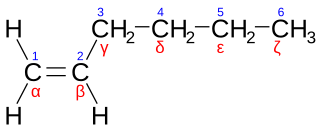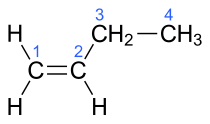
In organic chemistry, an alkene, or olefin, is a hydrocarbon containing a carbon–carbon double bond. The double bond may be internal or in the terminal position. Terminal alkenes are also known as α-olefins.

In organic chemistry, a diene ; also diolefin, dy-OH-lə-fin) or alkadiene) is a covalent compound that contains two double bonds, usually among carbon atoms. They thus contain two alkene units, with the standard prefix di of systematic nomenclature. As a subunit of more complex molecules, dienes occur in naturally occurring and synthetic chemicals and are used in organic synthesis. Conjugated dienes are widely used as monomers in the polymer industry. Polyunsaturated fats are of interest to nutrition.

Ethylene is a hydrocarbon which has the formula C2H4 or H2C=CH2. It is a colourless, flammable gas with a faint "sweet and musky" odour when pure. It is the simplest alkene.

Petrochemicals are the chemical products obtained from petroleum by refining. Some chemical compounds made from petroleum are also obtained from other fossil fuels, such as coal or natural gas, or renewable sources such as maize, palm fruit or sugar cane.
In organic chemistry, butyl is a four-carbon alkyl radical or substituent group with general chemical formula −C4H9, derived from either of the two isomers (n-butane and isobutane) of butane.

Isobutylene is a hydrocarbon with the chemical formula (CH3)2C=CH2. It is a four-carbon branched alkene (olefin), one of the four isomers of butylene. It is a colorless flammable gas, and is of considerable industrial value.
In organic chemistry, hexene is a hydrocarbon with the chemical formula C6H12. The prefix "hex" is derived from the fact that there are 6 carbon atoms in the molecule, while the "-ene" suffix denotes that there is an alkene present—two carbon atoms are connected via a double bond. There are several isomers of hexene, depending on the position and geometry of the double bond in the chain. One of the most common industrially useful isomers is 1-hexene, an alpha-olefin. Hexene is used as a comonomer in the production of polyethylene.
But-2-ene is an acyclic alkene with four carbon atoms. It is the simplest alkene exhibiting cis/trans-isomerism (also known as (E/Z)-isomerism); that is, it exists as two geometric isomers cis-but-2-ene ((Z)-but-2-ene) and trans-but-2-ene ((E)-but-2-ene).

Pentenes are alkenes with the chemical formula C
5H
10. Each molecule contains one double bond within its molecular structure. Six different compounds are in this class, differing from each other by whether the carbon atoms are attached linearly or in a branched structure and whether the double bond has a cis or trans form.
Octene is an alkene with the formula C
8H
16. Several isomers of octene are known, depending on the position and the geometry of the double bond in the carbon chain.
A polyolefin is a type of polymer with the general formula (CH2CHR)n where R is an alkyl group. They are usually derived from a small set of simple olefins (alkenes). Dominant in a commercial sense are polyethylene and polypropylene. More specialized polyolefins include polyisobutylene and polymethylpentene. They are all colorless or white oils or solids. Many copolymers are known, such as polybutene, which derives from a mixture of different butene isomers. The name of each polyolefin indicates the olefin from which it is prepared; for example, polyethylene is derived from ethylene, and polymethylpentene is derived from 4-methyl-1-pentene. Polyolefins are not olefins themselves because the double bond of each olefin monomer is opened in order to form the polymer. Monomers having more than one double bond such as butadiene and isoprene yield polymers that contain double bonds (polybutadiene and polyisoprene) and are usually not considered polyolefins. Polyolefins are the foundations of many chemical industries.

1-Hexene (hex-1-ene) is an organic compound with the formula C6H12. It is an alkene that is classified in industry as higher olefin and an alpha-olefin, the latter term meaning that the double bond is located at the alpha (primary) position, endowing the compound with higher reactivity and thus useful chemical properties. 1-Hexene is an industrially significant linear alpha olefin. 1-Hexene is a colourless liquid.

In organic chemistry, terminal alkenes are a family of organic compounds which are alkenes with a chemical formula CxH2x, distinguished by having a double bond at the primary, alpha (α), or 1- position. This location of a double bond enhances the reactivity of the compound and makes it useful for a number of applications.

Straight-chain terminal alkenes, also called linear alpha olefins (LAO) or normal alpha olefins (NAO), are alkenes (olefins) having a chemical formula CnH2n, distinguished from other alkenes with a similar molecular formula by being terminal alkenes, in which the double bond occurs at the alpha position, and by having a linear (unbranched) hydrocarbon chain.
In chemical separation terminology, the raffinate is a product which has had a component or components removed. The product having the removed materials is referred to as the extract. For example, in solvent extraction, the raffinate is the liquid stream which remains after solutes from the original liquid are removed through contact with an immiscible liquid. In metallurgy, raffinating refers to a process in which impurities are removed from liquid material.

But-1-ene (or 1-butylene) is the organic compound with the formula CH3CH2CH=CH2. It is a colorless gas. But-1-ene is an alkene easily condensed to give a colorless liquid. It is classified as a linear alpha-olefin (terminal alkene). It is one of the isomers of butene (butylene). It is a precursor to diverse products.

1-Octene is an organic compound with a formula CH2CHC6H13. The alkene is classified as a higher olefin and alpha-olefin, meaning that the double bond is located at the alpha (primary) position, endowing this compound with higher reactivity and thus useful chemical properties. 1-Octene is one of the important linear alpha olefins in industry. It is a colourless liquid.
Decene is an organic compound with the chemical formula C10H20. Decene contains a chain of ten carbon atoms with one double bond, making it an alkene. There are many isomers of decene depending on the position and geometry of the double bond. Dec-1-ene is the only isomer of industrial importance. As an alpha olefin, it is used as a comonomer in copolymers and is an intermediate in the production of epoxides, amines, oxo alcohols, synthetic lubricants, synthetic fatty acids and alkylated aromatics.
Polybutene is an organic polymer made from a mixture of 1-butene, 2-butene, and isobutylene. Ethylene steam cracker C4s are also used as supplemental feed for polybutene. It is similar to polyisobutylene (PIB), which is produced from essentially pure isobutylene made in a C4 complex of a major refinery. The presence of isomers other than isobutylene can have several effects including: 1) lower reactivity due to steric hindrance at the terminal carbon in, e.g., manufacture of polyisobutenyl succinic anhydride (PIBSA) dispersant manufacture; 2) the molecular weight—viscosity relationships of the two materials may also be somewhat different.

Four-carbon molecules are based on a skeleton made from four carbon atoms. They may be in a chain, branched chains, cycles or even bicyclic compounds





















